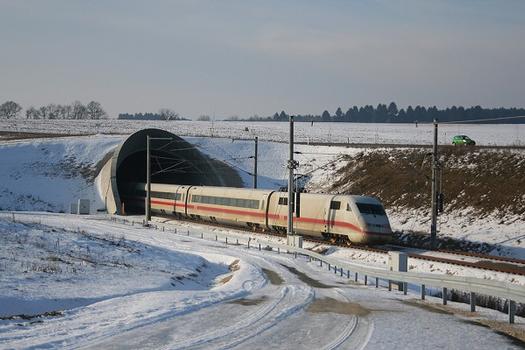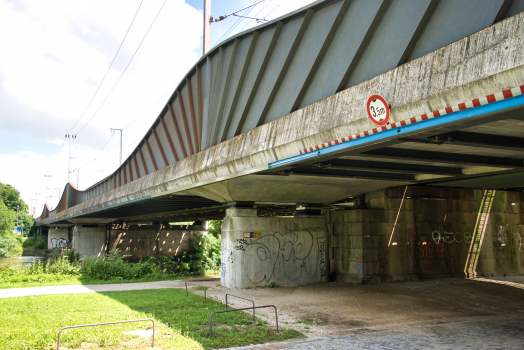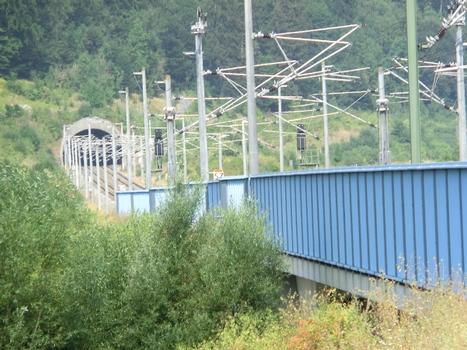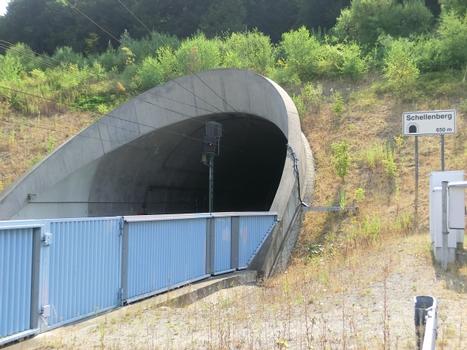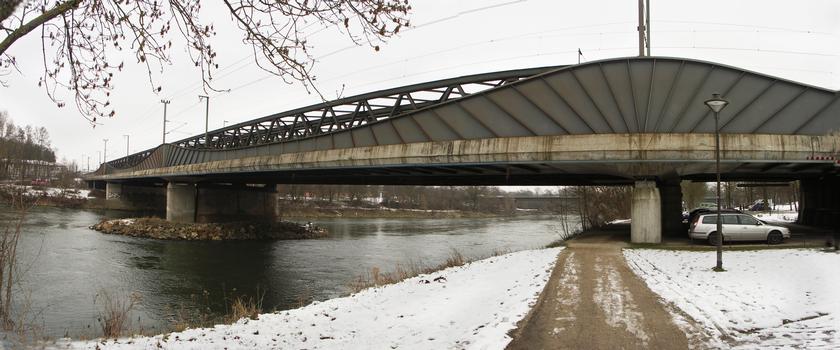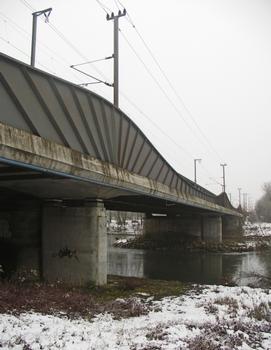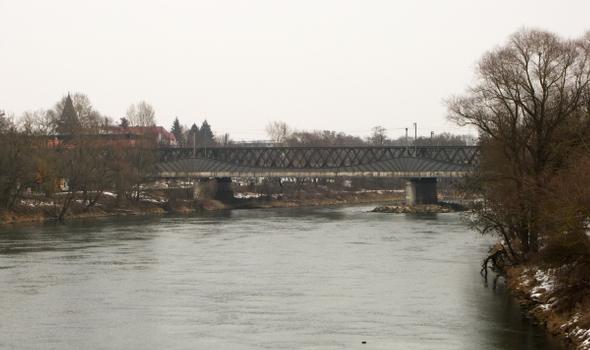High-speed rail line Nuremberg - Ingolstadt - Munich
General Information
| Other name(s): | Neu- und Ausbaustrecke Nürnberg - Ingolstadt - München |
|---|---|
| Beginning of works: | 1998 |
| Completion: | 2006 |
| Status: | in use |
Project Type
| Function / usage: |
High-speed rail line |
|---|
Location
| km | Name |
| 25.400 | |
| 78.085 |
Technical Information
Dimensions
| length | 171 km |
Design Loads
| design speed | 300 km/h |
Cost
| cost of construction | ca. Euro 3 600 000 000 |
Chronology
| 28 May 2006 | Opening of the section Nuremberg-Ingolstadt, a newly constructed line. |
|---|---|
| December 2006 | Opening of the section Munich-Ingolstadt, a refurbished track. |
Excerpt from Wikipedia
The Nuremberg–Munich high-speed railway line is a 171 kilometre-long (106 miles) high-speed railway running between the two largest cities in Bavaria, Germany: Nuremberg and Munich.
The northern section, between Nuremberg and Ingolstadt, is a 300 km/h (186 mph) track built between 1998 and 2006. It is 90.1 km (56.0 mi) in length with nine tunnels (total length: 27 km or 17 mi). In order to minimize damage to the environment, it runs for the most part right next to Bundesautobahn 9. The southern section, between Ingolstadt and Munich, is 19th-century track. Ist southern section has been upgraded for up to 200 km/h (124 mph). Between 2010 and 2013, further upgrades to the midsection of the track will be done. The minimum speed on the Munich-Ingolstadt section should then be 160 km/h (99 mph), with 190 km/h (118 mph) in the middle and 200 km/h in the southern section.
Both long-distance and regional services operate on the line. Intercity-Express trains reach the tracks' 300 km/h speed-limit. InterCity and RegionalExpress trains travel at a maximum speed of 200 km/h. The Allersberg-Express, a RegionalBahn shuttle service, is operated between Allersberg and Nuremberg. The line was officially inaugurated on May 13, 2006. Limited operation with a twice-hourly long-distance service started on 28 May 2006. The line has been in full operation since December 2006. Compared to the former track via Augsburg, it cut off 29 km (18 mi), or about 30 minutes journey time on long-distance and an hour on regional trains.
Most of the track is equipped with Linienzugbeeinflussung and GSM-R. ETCS was planned to be introduced in 2009, although this seems to be delayed until at least 2017. The total costs (as of January 2006) were about €3.6 billion. The line is part of the Line 1 of Trans-European Transport Networks (TEN-T).
History
The Irlahüll Tunnel (7,260 m or 23,819 ft) is one of the longest and steepest (20 permille) rail tunnels in Germany.
The Munich–Ingolstadt line was opened in 1867 and was extended to Treuchtlingen as the Ingolstadt–Treuchtlingen line in 1870.
The first proposal for a high-speed line dates back to 1983, when the Nuremberg section of Deutsche Bundesbahn proposed a more direct line between Nuremberg and Munich. The project was added to the 1985 federal traffic infrastructure plan. The following years were marked by heated debate on the route of the line, in particular if it should run via Ingolstadt or Augsburg. While the Ingolstadt line is much more direct (171 km or 106 mi) than the existing Augsburg route (199 km or 124 mi), the metropolitan area of Augsburg is considered much larger than Ingolstadt's. Apart from concerns that fewer long-distance trains would run via (and stop at) Augsburg, there were also concerns about the environmental effects of the 75 km (47 mi) of track that had to be built from scratch. Large-scale construction began in 1998, when numerous disputes had finally been settled and the total cost was estimated to be €2.3 billion. The €1.3 billion cost increase arose from numerous geological problems found during construction and additional works required to meet environmental and security concerns.
On 2 September 2006, Österreichische Bundesbahnen (ÖBB) locomotive 1216 050 (Siemens Eurosprinter) set a new world record for locomotives with a top speed of 357 km/h (222 mph); reached near Hilpoltstein.
Text imported from Wikipedia article "Nuremberg–Munich high-speed railway" and modified on July 22, 2019 according to the CC-BY-SA 4.0 International license.
Participants
Relevant Web Sites
There currently are no relevant websites listed.
Relevant Publications
- (2003): Baugrunderkundung für Verkehrswege in Karstgebieten am Beispiel der NBS Nürnberg-Ingolstadt. In: Felsbau, v. 21, n. 1 ( 2003), pp. 13.
- (2004): Eisenbahntunnelbau in Karstgebieten – Erfahrungen beim Bau der DB Neubaustrecke Nürnberg – Ingolstadt. In: Bauingenieur, v. 79, n. 6 (June 2004), pp. 264+.
- (2003): Maßnahmen für den Tunnelvortrieb im verkarsteten Gebirge der NBS Nürnberg-Ingolstadt. In: Felsbau, v. 21, n. 1 ( 2003), pp. 22.
- (1999): NBS Nürnberg-Ingolstadt. Knackpunkte in der Abwicklung der Tunnelobjekte. In: Felsbau, v. 17, n. 5 ( 1999).
- (2005): Die Neubaustrecke Nürnberg-München. Eine Tagung der Verlagsgruppe Wiederspahn. In: [ Umrisse ], v. 5, n. 6 ( 2005), pp. 48-49.
- About this
data sheet - Structure-ID
10000103 - Published on:
24/06/2002 - Last updated on:
20/01/2022

